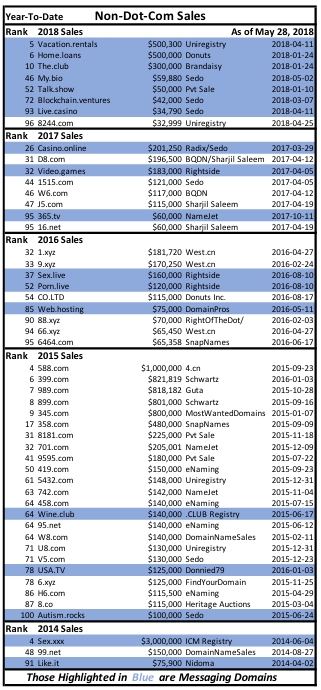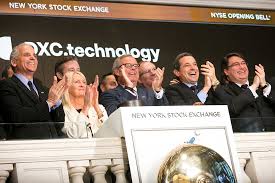That, combined with what’s hip and cool today: using a word play in your website address or being first to deploy an ideally positioned Non Dot Com. For example, CloudWi.re, Join.Me, Del.icio.us, or DXC.Technology shown here going public.
Actionable Brands are Back!
DXC Technology is a 7.6 Billion dollar company, so they certainly weren’t compelled to use some left-over domain address. In fact, they bought DXC.com for six-figures— the ideal Dot Com— yet chose to standout by hosting their global site and creating a logo around the hip, new domain, DXC.Technolgy, which they hand-registered.
DXC.Technolgy serves as both their moniker and a clickable brand. That simply doesn’t work with a Dot Com anymore, but do you know why?
Were you to brand with a Dot Com address you’d be projecting the stigma associated its 30-year history. Sure, you’ll get the clickability of the “Dot,” but can’t avoid looking like some silly, wannabe Dot Com from the 90’s— only 2 decades late! Even companies that formed in the 90's have dropped the Dot Com from their brands in response the embarrassing crash in the early 2000's, i.e. to disassociate themselves from the Dot Bombs.
Only a Non Dot Com domains combine hip and cool with functionality. DXC gets this. They live this. Non Dot Com branding is the bridge from the past to the present and beyond. This is the promise of an actionable brand without all the baggage, enticing users to type direct and avoid search— where they are sure to be exposed to competitive websites.
Surging Non-Dot-Com adoption
While very affordable— often 10% of a Dot Com's cost— Non Dot Coms must exactly match your positioning. For example, Wine.com may be used for anything related to wine, while Wine.Shop is clearly a different play then Wine.Club. When your market position is in harmony with the messaging, say Wine.Club for a wine club, Non Dot Coms are as good as it gets.
And that’s not just an opinion. Wine.Club sold at auction in 2015 for $140,000 where the high bid for WineClub.Com was only $60,000, and failed to meet the reserve in a 2017 auction. Had these domains been sold side-by-side, on the same day, I believe the Dot Com may have gone for more, but the messaging in Wine.Club is clearly superior than the domain with the dangling dot com.
Home.Loans sold for $500,000 in early 2018. All indications are that this purchase was a bargain, as Home.Loans will be capturing value for years to come in a market measured in trillions.
With over a thousand domain extensions, it is now messaging that matters, not the mere functionality of the Dot. They all “Dot” the same. The most valuable Non Dot Coms will be those that precisely represent market categories, like Auto.Glass, Options.Exchange, Translate.Info, or Streamed.Live.
Experience has borne this out. The largest Non Dot Coms sales to date mostly represent categories: Home.Loans, Vacation.Rentals, Wine.Club, Video.Games, Casino.Online, and Web.Hosting.
While it may take years for Non Dot Coms to displace the traditional five as the go-to domains, many will emerge as famous brands. Join.Me, for example, is built on a compelling message for a shared-screen experience, as is Zoom.US. We may use Telex.Live for our new phone-web integration platform.
Yet, en mass, Non Dot Coms are on track to surpass the registrations of Dot Coms alone in the next few years— certainly once acquisition and holding costs are reduced. As of Dec, 2017, ICANN reported that overall Non Dot Coms adoption is 17.9%* of Dot Com registrations, and already exceeds Dot Nets sales by 62.7%.
That means, consumers are rapidly becoming aware of the distinction, not of any one Non Dot Com— there will be thousands— but that there are new ways to do the Dot.
* Total gTld as of Dec, 2018 were 23.6 million vs. 131.9 Dot Com and 14.5 Dot Net registrations at year's end





